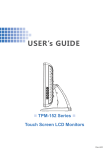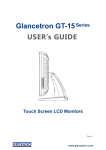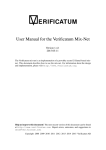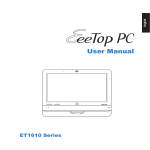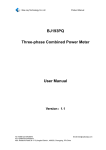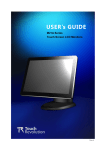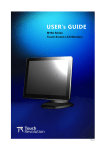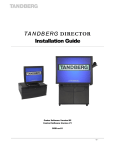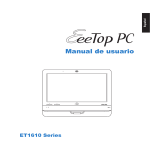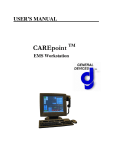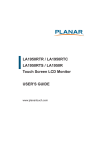Download User manual - Jarltech.com
Transcript
USER’s GUIDE TPM-193 Series Touch Screen LCD Monitors The information contained in this document is subject to change without notice. This document contains proprietary information that is protected by copyright. All rights are reserved. Nopart of this document may be reproduced,translated to another language or stored in a retrieval system, or transmitted by any means, electronic, mechanical, photocopying, recording, or otherwise, without prior written permission. Windows is a registered trademark of Microsoft, Inc. Other brand or product names are trademarks of their respective holders. Important Recycle Instruction: Lamp(s) inside this product contains mercury. This product may contain other electronic waste that can be hazardous if not disposed of properly. Recycle or dispose in accordance with local, state, or federal Laws. For more information, contact the Electronic Industries Alliance at WWW.EIAE.ORG. For lamp specific disposal information check WWW.LAMPRECYCLE.ORG. Table of Contents Usage Notice Precautions............................................................................................................................. 1 Introduction About TPM-193 Series ........................................................................................................... 2 Touch Screen for TPM-193 Series ............................................................................... 3 Package Overview ...................................................................................................... 4 Installation Product Overview ........................................................................................................ Front View ............................................................................................................... TPM-193R / TPM-193C Bottom View (Without Stand) .............................................. TPM-193W Bottom View (Without Stand) ................................................................. Kensington Security Slot .............................................................................................. VESA Mount for your Monitor....................................................................................... Start Your Installation .................................................................................................. Remove the Back Cover .......................................................................................... Connecting the Display (Figure 1.1) ............................................................................. 5 5 5 6 6 7 8 8 9 User Controls Front Panel Controls ................................................................................................... 11 How to Use the OSD Menus .......................................................................................12 On-Screen Display Menus ..........................................................................................13 Appendix Troubleshooting ..........................................................................................................14 Warning Signal ...........................................................................................................15 No signal .................................................................................................................15 Going to sleep ........................................................................................................15 Out of range ...........................................................................................................15 Product Dimensions ...................................................................................................16 Compatibility Modes ...................................................................................................17 Touch Screen Driver Installation .................................................................................18 Driver installation process ......................................................................................18 TPM-193R / TPM-193C Driver Install ......................................................................18 TPM-193W Driver Install .........................................................................................19 TPM-193C Optional Capacitive Calibration Tool Install............................................19 Usage Notice ! ! Warning - To prevent the risk of fire or shock hazards, do not expose this product to rain or moisture. Warning - Please do not open or disassemble the product as this may cause electric shock. Precautions Follow all warnings, precautions and maintenance as recommended in this user’s manual to maximize the life of your unit. Do: • Turn off the product before cleaning. • Touch screen surface may be cleaned using a soft clean cloth moistened with mild window glass commercial cleaners or 50/50 mixture of water and isopropyl alcohol. • Use a soft cloth moistened with mild detergent to clean the display housing. • Use only high quality and safety approved AC/DC adapter. • Disconnect the power plug from AC outlet if the product is not going to be used for an extended period of time. Don’t: • Do not touch the LCD Display screen surface with sharp or hard objects. • Do not use abrasive cleaners, waxes or solvents for your cleaning. • Do not operate the product under the following conditions: - Extremely hot, cold or humid environment. - Areas susceptible to excessive dust and dirt. - Near any appliance generating a strong magnetic field. - In direct sunlight. 1 Introduction About TPM-193 Series The TPM-193 Series is a 19" flat panel screen with an active matrix, thin-film transistor (TFT) liquid crystal display (LCD). Features include: • Direct Analog signal input • Active matrix TFT LCD technology • 1280 x 1024 SXGA resolution • 19" viewable display area • 31.5 ~ 81 KHz horizontal scan • 56.3 ~ 75 Hz high refresh rate • 0.294mm x 0.294mm pixel pitch • Auto adjustment function • Multilingual OSD user control • Kensington security slot • 100 mm VESA mount • Removable base for flexible mounting solutions. • TPM-193R- 5-wire resistive touch screen with dual RS-232 Serial / USB controller • TPM-193W - SAW touch screen with USB controller • TPM-193C - Capactive touch screen with dual RS-232 Serial / USB controller • Built-in speakers-1W x 2 Touch Screen for TPM-193R • Analog 5-wire resistive touch screen for finger and stylus input • Surface: Anti-glare treatment • Interface: Dual RS-232 Serial/USB controller • Transmittance: 80±5% • Driver: Windows® VISTA, XP, 2000, ME, 98, CE, XP Embedded, Linux/Apple® Mac OS Touch Screen for TPM-193W • Surface Acoustic Wave (SAW) touch screen for finger and stylus input • Surface: Anti-glare treatment • Interface: USB controller • Transmittance: 90±5% • Driver: Windows® VISTA 64/32 bits, XP, 2000, 98 2 Touch Screen for TPM-193C • Analog capacitive touch screen for finger input only • Surface: Anti-glare treatment • Interface: Dual RS-232 Serial/USB controller • Transmittance: 85±5% • Driver: Windows® VISTA, XP, 2000, ME, 98, CE, XP Embedded, Linux/Apple® Mac OS 3 Package Overview LCD Display Power Cord USB Cable ( A to B) Audio-in Cable USB Cable (A to A) (Option for MSR) TouchKit CD DVI-D Cable (TPM-193X Series Only) DC Power Supply (sold separately) 4 VGA Signal Cable RS-232 Cable Quick Start Guide Product Overview • Front View • TPM-193R / TPM-193C Bottom View (Without Stand) Audio VGA IN AC IN DVI IN RS-232 (Option) USB DC IN • TPM-193W Bottom View (Without Stand) Audio VGA IN AC IN DVI IN USB DC IN 5 Kensington Security Slot The monitor can be secured to your desk or any other fixed object with Kensington lock security products. The Kensington lock is not included. 6 VESA Mount your monitor This monitor conforms to the VESA Flat Panel Mounting Physical Mounting Interface standard which defines a physical mounting interface for flat panel monitors, and corresponding with the standards of flat panel monitor mounting devices, such as wall and table arms. The VESA mounting interface is located on the back of your monitor. To mount the monitor on a swing arm or other mounting fixture, follow the instructions included with the mounting fixture to be used, please note to mount your monitor to the devices (either mounting fixture or swing arm) what conforms to the UL listed. ! Warning! Please select the proper screws! The distance between the back cover surface and the bottom of the screw hole is 8 mm. Please use four M4 screws diameter with the maximum length of 8 mm to mount your monitor. Please note the mounting stand shall be able to sustain at least 5Kg weight. 7 Start Your Installation Remove the Back Cover Please follow these instructions to remove the cover on the back panel of the LCD so that you can hookup the cables to associated connector. Figure A 1. To remove the back cover, follow the arrows in figure A and pull out with your fingers and the cover should be removed from the stand. 2. Follow the instructions on P.10 (Figure 11.1) to connect the cables to the appropriate connectors. 3. Attach the cover back to the LCD stand by pressing firmly until the tabs snap into place. You may also keep the cables in order by using the cable organizer. ! Note! You can place the LCD flat horizontally to make it easier to connect the cables. Please make sure that you place it on an even surface lest the LCD should be damaged by scratches or collision. included cables organizer 8 Connecting the Display (Figure 11.1) To setup this display, please refer to the following figure and procedures. 1. 2. 3. 4. 5. 6. 7. ! Be sure all equipments are turned off. Connect the AC power cord to the power connector on the monitor and the other end into an electrical outlet (11.1). Connect the D-SUB or DVI cable from the display’s VGA input connector to the D-SUB or DVI connector of your host computer and tighten the screws (11.1). Connect the Audio-In cable from the audio input port of your display to the Audio-out port of your computer (11.1). Connect the RS-232 or USB cable from the RS-232 or USB port of your display to the RS-232 port (11.1) or USB port (11.1) of your computer. Configure the touch screen. Refer to the “Touch Screen Driver Installation” section on Page 18. Once the touch screen is configured, the monitor is ready for use. Notice! To ensure the LCD display works well with your computer, please configure the display mode of your graphics card to make it less than or equal to 1280 x 1024 resolution and make sure the timing of the display mode is compatible with the LCD display. We have listed the compatible “Video Modes” of your LCD display in the appendix (on page 14) for your reference. 9 (Figure 11.1) 10 User Controls Front Panel Controls No / Icon Menu No Icon Control Function Menu Menu button Display the OSD menus ▲ Brightness Plus Clockwise 1.Enter brightness of the OSD. 2.To increase value of the adjustment items. 3.Select item clockwise. ▼ Mute Minus 1.To decrease value of the adjustment items. 2.Select item count-clockwise. Select Auto Adjust Select: Select the adjustment items from OSD menus. Auto Adjust: Activate the “Auto Adjustment” function to obtain the optimum image. Power Switch Switches on/off the power of the LCD display. 11 How to Use the OSD Menus 1. Press the “MENU” button to pop up the “on-screen menu” and press “▲” or “▼” to select among the six functions in the main menus. 2. Choose the adjustment items by pressing the “ ” button. 3. Adjust the value of the adjustment items by pressing the “▲” or “▼” button. (1) The OSD menu will automatically close, if you have left it idle for a pre-set time. (2) To disable the OSD / Power menu buttons, please follow the instructions below: (Please note: the monitor has to be turned ON with a valid signal preset) a. Press and hold the “Power” and “Menu” key simultaneously for 1 seconds. b. The wording “OSD Lock” / “Power Lock” will appear for 2 seconds on the monitor. This indicates that all the front buttons, with the exception of the power button, are now disabled. (3) To enable the OSD / Power menu buttons, please follow the instructions below. (Please note: the monitor has to be ON with a valid signal present.) a. Press and hold the “Power” and “Menu” key simultaneously for 1 seconds. b. The wording “OSD Unlock” / “Power Unlock” will appear for 2 seconds on the monitor. This indicates that all the front buttons are now enabled. 12 On-Screen Display Menus Main OSD Menu: MAIN MENU SUB Menu Function Description Contrast 0-100 Adjusts the maximum luminance level of the monitor. Brightness 0-100 Adjusts the backlight of the monitor. Auto Adjust NO / YES Left / Right 0-100 Down / Up 0-100 The screen is moved vertically up and down (1 line increment). Horizontal size 0-100 The ratio of dividing frequency of the dot clock is adjusted. Fine 0-100 The phase of the dot clock is adjusted. OSD Left / Right 0-100 Adjusts the OSD menu screen position left or right. OSD Up / Down 0-100 Adjusts the OSD menu screen position up or down. OSD Time out 5-60 Adjusts the amount of the OSD menu is displayed. The screen is moved horizontally right and left (1 pixel pitch increment). The screen is moved horizontally right and left (1 pixel pitch increment). Select the language used for the OSD menu among English, French, Japanese, Deutsch, Spanish, Italian, Traditional OSD Language Chinese and Simplified Chinese. Factory Reset NO / YES Restores original factory settings. Sets the color temperature.9300, 6500, 5500, 7500, User. RGB Volume 0-100 To adjust the volume. Mute ON / OFF To turn ON/OFF the sound. 13 Appendix Troubleshooting If you are experiencing trouble with the LCD display, refer to the following. If the problem persists, please contact your local dealer or our service center. Problem: No image appears on screen. ► Check that all the I/O and power connectors are correctly and well connected described in the "Installation" section. ► Make sure the pins of the connectors are not crooked or broken. Problem: Partial Image or incorrectly displayed image. ► Check to see if the resolution of your computer is higher than that of the LCD display. ► Reconfigure the resolution of your computer to make it less than or equal to 1280 x 1024. Problem: Image has vertical flickering line bars. ► Use "Fine" to make an adjustment. ► Check and reconfigure the display mode of the vertical refresh rate of your graphic card to make it compatible with the LCD display. Problem: Image is unstable and flickering ► Use "Horizontal size" to make an adjustment. Problem: Image is scrolling ► Check and make sure the VGA signal cable (or adapter) is securely connected. ► Check and reconfigure the display mode of the vertical refresh rate of your graphics card to make it compatible with the LCD Display. Problem: Vague image (characters and graphics) ► Use "Fine" to make an adjustment. If this problem still exists, use "Horizontal size" to make an adjustment. 14 Warning Signal If you see warning messages on your LCD screen, this means that the LCD display cannot receive a clean signal from the computer graphics card. There may be three sources for this problem. Please check the cable connections or contact your local dealer or our service center for more information. ► No Signal This message means that the LCD Display has been powered on but it cannot receive any signal from the computer graphics card. Check all the power switches, power cables, and VGA signal cable. ► Going to sleep The LCD is under the power saving mode, in addition, the LCD will go into this sleep mode when experiencing a sudden signal disconnecting problem. ► Out of Range This message means that the signal of the computer graphic card is not compatible with the LCD display. When the signal is not included in the "Video Modes" list we have listed in the Appendices of this manual, the LCD monitor will display this message. 15 Product Dimensions 370.00 405.50 438.00 Front View 67.90 267.40 Top View Side View 16 Compatibility Modes Mode Resolution H-Frequency (KHz) V-Frequency (Hz) IBM VGA 720 x 400 31.5 70 IBM VGA 640 x 480 31.5 60 VESA VGA 640 x 480 37.9 72 VESA VGA 640 x 480 37.5 75 VESA SVGA 800 x 600 35.2 56 VESA SVGA 800 x 600 37.9 60 VESA SVGA 800 x 600 48.1 72 VESA SVGA 800 x 600 46.9 75 VESA XGA 1024 x 768 48.4 60 VESA XGA 1024 x 768 56.5 70 VESA XGA 1024 x 768 60 75 VESA SXGA 1280 x 1024 64 60 1280 x 1024 80.0 75 1280 x 960 60 60 1152 x 864 67.5 75 Apple Mac II 640 x 480 35.0 67 Apple Mac 832 x 624 49.7 75 VESA SXGA 17 Touch Screen Driver Installation The touch driver is located on the enclosed CD-ROM disk for these OS: Windows ME / 2000 / XP / Vista / XP Embedded, Linux, CE.NET Driver Installation Process: 1. Before you start to install the touch driver, please be sure the USB or the RS-232 Serial cable is connected from the PC or the LCD display. 2. Uninstall any touch screen driver that may be on your system. 3. Click on the driver link found on the CD-ROM. 4. Follow instructions as found below. 5. After installation is complete, click “Finish” and restart your computer to complete installation. TPM-193R / TPM-193C Driver Install: Please Note: The TPM-193R/TPM-193C is available with both RS232 and USB connections. If you are using RS232 connection, follow the instructions below: 1. Be sure that RS232 cable is connected from the computer. 2. Power on the computer. 3. Load the touch screen driver CD. 4. Follow the step-by-step instructions as shown on pop-up windows. If you are using USB connection on VISTA, follow the instructions below: 1. Be sure that USB cable is connected from the computer. 2. Power on the computer. 3. No need to install USB driver from CD due to it is the HID device, system will recognize the HID device and load driver automatically. Please note: Do not plug in both RS232 and USB cables. Doing so may cause a driver conflict, making your touch screen idle. If you are using USB connection on non-VISTA operation system, follow the instructions below: 1. Be sure that USB cable is connected from the computer. 2. Power on the computer. 3. Load the touch screen driver CD. 4. Follow the step-by-step instructions as shown on pop-up windows. 18 TPM-193W Driver Install: 1. Be sure that USB cable is connected from the computer. 2. Power on the computer. 3. Load the touch screen driver CD. 4. Follow the step-by-step instructions as shown on pop-up windows. Please Note: The TPM-193C with Capacitive Touch Screen is Microsoft ® Windows®HID (Human Interface Device) compatible if you use the USB touch screen interface. No additional software driver is required for general operation of the touch screen. A special calibration tool can be installed for touch position accuracy. improvement See “Optional Capacitive Calibration Tool Install” section for more information. TPM-193C Optional Capacitive Calibration Tool Install: If you would like to use the Optional Capacitive Calibration Tool, follow the instructions below: 1. Load the driver CD to your CD-Rom driver. 2. Open the “CalTouch” folder. 3. Click “CalTouch.exe” to execute calibration process 4. The HID Touch Digitizer calibration tool will automatically open. From here the user can choose the operations following: a. 4 Points Calibration b. 9 Points Linearization c. 25 Points Linearization d. Clear e. Draw Test f. Advanced. In the Advanced settings area the user may do the adjustment/ operation following: i. Adjust the Double Click Area ii. Enable auto right click and adjust the auto right click time iii. Choose to be either in the HID Mouse Mode or HID Digitizer Mode iv. Simply click the “Apply” button once the settings are finalized. 19






















